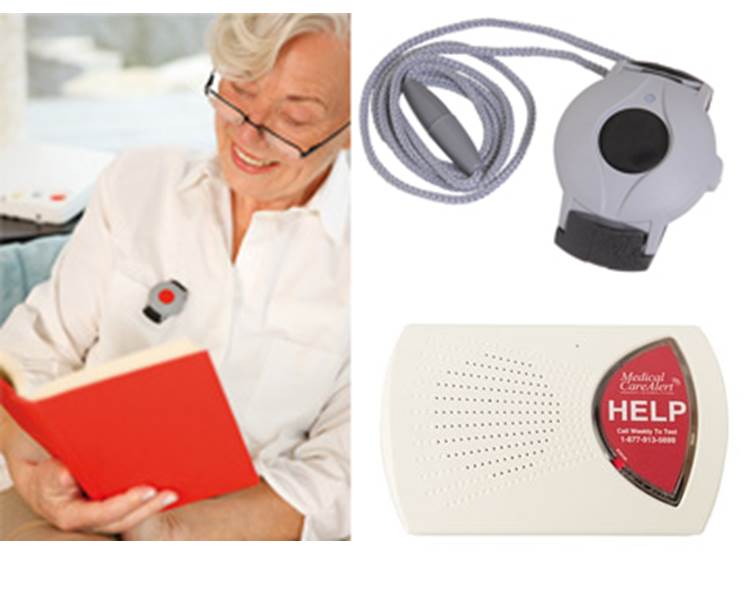October 24, 2014 – Today’s guest blogger, Charlie Kimball, works for Medical Care Alert, a Michigan-based company providing home care monitoring for family members who choose to stay at home despite medical challenges. Charlie is a graduate of Wayne State University in Detroit. She blogs for her company and her contribution to 21st Century Tech blog discusses the current state of home health monitoring and speculates on its future.
A personal note, my first encounter with this type of technology involved both my father and father-in-law. The former agreed to a home medical alert system after my mother developed Alzheimer’s and his health started to fail complicated by prostate and lung cancer as well as heart disease. My dad passed away at home at age 84. My father-in-law also agreed to a medical home alert system when he reached his mid-90s. Until then he seldom had run into medical difficulties. But when he started experiencing blackouts and falls it was time. He passed away at age 97 and the home alert system of both of my families made it possible for them to remain at home until their deaths.
I thank Charlie for her contribution today and for the blogging she does for her company at MedicalCareAlert.com. Enjoy her contribution and please feel free to comment.
————
Advances in technology have helped us live longer, stay at home, and remain independent. Technology provides a safety net making this the first generation capable of independent living rather than having to make the decision to sell a home, or move in with children, or even move to a retirement facility or home for the aged.
Where are advances in health monitoring happening? Take a look at hospitals for your answer. Patient monitoring is now a $30 billion US business, and growing by 10% just in the last year. And forecasters see no signs of the slowing down in growth as our population ages.
All this monitoring technology gives us access to a host of data points that can be tracked and analyzed. Your blood pressure changes while you read this article. Your temperature rises and falls as your body adjusts to the chair. Perhaps the cut you received yesterday is showing signs of healing. All can be tracked.
Humans are the target of big data and up until recently, we knew the data points to collect, but didn’t have the tools to monitor the data in near-real time. Technology today is getting us closer and closer to this capability. And we are making advances with technology devices that will soon let us predict future health.
Let’s start with the technology behind medical alert systems. Medical alert systems, or personal emergency response systems, were created in the 1970s to offer communications and a safety net for disabled, elderly, and those with medical issues.
Current medical alert technology combines base devices connected to a remote monitoring systems and a device worn by the individual requiring the service. Usually a pendant or bracelet, the user has the option to press a button to communicate with a remote call center that dispatches emergency personnel or loved ones to the scene. The system works if the user remembers to wear the emergency communication device and has the means to access setting off the alarm should an emergency require it. The wearer, however, has to be within range of the home-installed communications base. Some medical alert technologies include fall detection, automatically telling the monitoring facility that the wearer has had an accident. Monitoring is continuous 24×7 and in the event of an alert can lead to enabling two-way communications through the communications base to the wearer plus the alerting of loved ones and emergency personnel.
The technology is advancing to make it dementia-proof. With smart watches, remote diagnosis, patient monitoring systems (developed for hospitals), new big data analysis techniques, and the rapid miniaturization of complex systems architecture, we are rapidly approaching a time where users of medical alerts will be provided with a complete safety net simply by wearing a bracelet.
Wearable technology like smart watches can incorporate a variety of sensors and run applications that provide readouts of a person’s vital signs, blood oxygen levels, heart rate, skin temperature and more. Not only can these smart devices broadcast this information to private web pages where the user can view the data, they can also share this information with medical professionals.
Medical alert systems recognize that smart watches will soon replace the traditional bracelet and pendant and there is even more on the horizon. These smart watches can literally become medical labs for home healthcare monitoring. In the next few years lab-on-a-chip technology will be integrated to work with such devices. Patients will be able to share blood sugar levels and other vital health data directly with medical professionals. Imagine a smart watch device that will read pacemaker data and transmit it automatically to a patient’s cardiologist.
The next revolution in medical monitoring will come from nano implants. With such devices and an external means of capturing the information such as a smart watch, detailed medical data will be available continuously for those who require this type of monitoring.
Will all of us find ourselves a walking database of medical information broadcasting our current status to our physicians? No.
Is there a danger of having sensitive medical data stolen by hackers? Possibly.
But these are the challenges when disruptive technologies first get introduced.
The benefits for an aging population, however, cannot be underestimated: independent living for far longer, better medical care because of better data, and better outcomes.











[…] into the caregiver role may not know why getting a medical alert device can be a boon. Haven’t smart phones and cellular technologies made these devices obsolete? They haven’t, and here’s […]
[…] Remote Health Monitoring Enters the 21st Century – She blogs for her company and her contribution to 21st Century Tech blog discusses the current state … were created in the 1970s to offer communications and a safety net for disabled, elderly, and those with medical issues. Current medical alert … […]